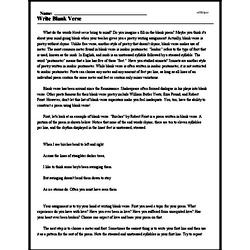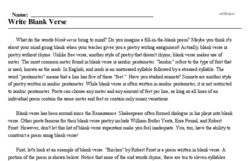Write Blank Verse
What do the words blank verse bring to mind? Do you imagine a fill-in-the-blank poem? Maybe you think it's about your mind going blank when your teacher gives you a poetry writing assignment! Actually, blank verse is poetry without rhyme. Unlike free verse, another style of poetry that doesn't rhyme, blank verse makes use of meter. The most common meter found in blank verse is iambic pentameter. "Iambic" refers to the type of foot that is used, known as the iamb. In English, and iamb is an unstressed syllable followed by a stressed syllable. The word "pentameter" means that a line has five of these "feet." Have you studied sonnets? Sonnets are another style of poetry written in iambic pentameter. While blank verse is often written in iambic pentameter, it is not restricted to iambic pentameter. Poets can choose any meter and any amount of feet per line, as long as all lines of an individual poem contain the same meter and feet or contain only minor variations.
Blank verse has been around since the Renaissance. Shakespeare often formed dialogue in his plays into blank verse. Other poets famous for their blank verse poetry include William Butler Yeats, Ezra Pound, and Robert Frost. However, don't let this list of blank verse superstars make you feel inadequate. You, too, have the ability to construct a poem using blank verse!
First, let's look at an example of blank verse. "Birches" by Robert Frost is a poem written in blank verse. A portion of the poem is shown below. Notice that none of the end words rhyme, there are ten to eleven syllables per line, and the rhythm displayed in the lines' feet is unstressed, stressed.
When I see birches bend to left and right
Across the lines of straighter darker trees,




